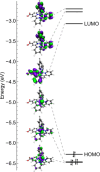Reaction-Type-Dependent Behavior of Redox-Hopping in MOFs─Does Charge Transport Have a Preferred Direction?
- PMID: 39572009
- PMCID: PMC11626502
- DOI: 10.1021/acs.jpclett.4c01674
Reaction-Type-Dependent Behavior of Redox-Hopping in MOFs─Does Charge Transport Have a Preferred Direction?
Abstract
Redox hopping is the primary method of electron transport through redox-active metal-organic frameworks (MOFs). While redox hopping adequately supports the electrocatalytic application of MOFs, the fundamental understandings guiding the design of redox hopping MOFs remain nascent. In this study, we probe the rate of electron and hole transport through a singular MOF scaffold to determine whether the properties of the MOF promote the transport of one carrier over the other. A redox center, [RuII(bpy)2(bpy-COOH)]2+, where bpy = 2,2'-bipyridine and bpy-COOH = 4-carboxy-2,2'-bipyridine, was anchored within NU-1000. The electron hopping coefficients (De) and ion diffusion coefficients (Di) were calculated via chronoamperometry and application of the Scholz model. We found that electrons transport more rapidly than holes in the studied MOF. Interestingly, the correlation between De and self-exchange rate built in previous research predicted reversely. The contradicting result indicates that spacing between the molecular moieties involved in a particular hopping process dominates the response.
Conflict of interest statement
The authors declare no competing financial interest.
Figures




 vs
vs  Scholz plots for reduction (c) and oxidation
(d) used to determine tref.
Scholz plots for reduction (c) and oxidation
(d) used to determine tref.


References
-
- Duan J.; Goswami S.; Patwardhan S.; Hupp J. T. Does the Mode of Metal–Organic Framework/Electrode Adhesion Determine Rates for Redox-Hopping-Based Charge Transport within Thin-Film Metal–Organic Frameworks?. J. Phys. Chem. C 2022, 126 (9), 4601–4611. 10.1021/acs.jpcc.1c09812. - DOI
LinkOut - more resources
Full Text Sources
Research Materials

